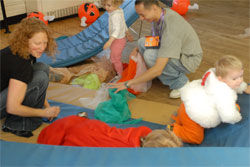Pumpkin Jam
On Halloween, Lori Custodero stood amid three pint-sized whirling dervishes who danced with brightly colored chiffon scarves, spun around (and then spun around again) and finally collapsed on the floor in a gale of giggles, all to the tune of “La Bamba” (the Ritchie Valens version, though Custodero says the children she has worked with respond best to the Los Lobos cut).
The children, ages two to four, were at TC for Custodero’s 10th annual “Pumpkin Playground,” organized by students from her Children’s Musical Development class.
As the music switched to the more mystical tones of Ladysmith Black Mambazo, the children continued their made-up game, in which the scarves were rain falling on them from the sky, then puddles to delightedly jump in.
Every year during the Halloween season, Custodero, Associate Professor of Music Education, invites children onto the campus for an afternoon of musical experiences that gives parents, caregivers and Custodero’s TC students, as well, a chance to interact with them in playful environments.
Research shows that babies are born musical, Custodero says. Children, from birth, respond to music and communicate musically, she says, and adults naturally speak to young children in high-pitched, sing-song, rhythmic cadences. Or as she puts it, “Children call forth the musicality of parents.”
For this year’s Pumpkin Playground, additional rooms had been set up -- one for art projects (origami and drawing) and musical instrument exploration (this was the most popular) and another for telling stories. Guided by the children’s imaginations, Custodero’s students told a story, with masks and puppets on hand for the children to use as needed. Back in the music and movement room, Kuan-Hui Leu, a graduate of TC’s master’s program in early childhood education and head teacher at the College’s Rita Gold Early Childhood Center, got up after rolling on the floor with Peter and Helena Goffi-Fynn, ages 2 and 4 respectively.
“I know Peter pretty well,” Leu said, “and he needs a lot of space. His personality comes out in a big room like this.” Peter, in a black mask, red cape and black leather gloves, lured Leu away to build a “bridge” out of padded mats over the scarf-water.
Rebecca Straayer, another student in Custodero’s class and music teacher for the Rita Gold Preschool, had Asher Olson, two, chasing a flashlight beam as she trained it first on the floor, then the ceiling. Asher’s brother, eight-month-old Sayer, bounced on his mother Morgan Olson’s stomach.
Custodero chose the next piece, the Beatles’ “Yellow Submarine,” knowing that Leu and Peter have a past relationship with this song. She wanted to see if Peter would recognize it and acknowledge the positive association, which he did.
“Many pre-service students have limited experience teaching children, and they often look to either the way they were taught or to published lesson plans for models,” Custodero says.“What they need to do is to stop and ask the question, how are children musical before we step in to educate them? Music is, in fact, the first way children communicate.”
Watching children respond to music also gives researchers a window into child development. Unlike language, music is an “honest” signal, from an evolutionary standpoint.
“Music, and response to music, Ican’t be faked,” Custodero says. “It is directly expressive – and interestingly, this point comes from the field of neuroscience.”
In the reading room, Custodero observed one of her students, Rachel Jaffe, dressed as the Tin Man from “The Wizard of Oz,” and began indulging in a moment of honest communication of her own, as she sidled up to a Steinway baby grand and began picking her way through the opening bars of “If I Only Had a Heart.”
Published Friday, Nov. 7, 2008
